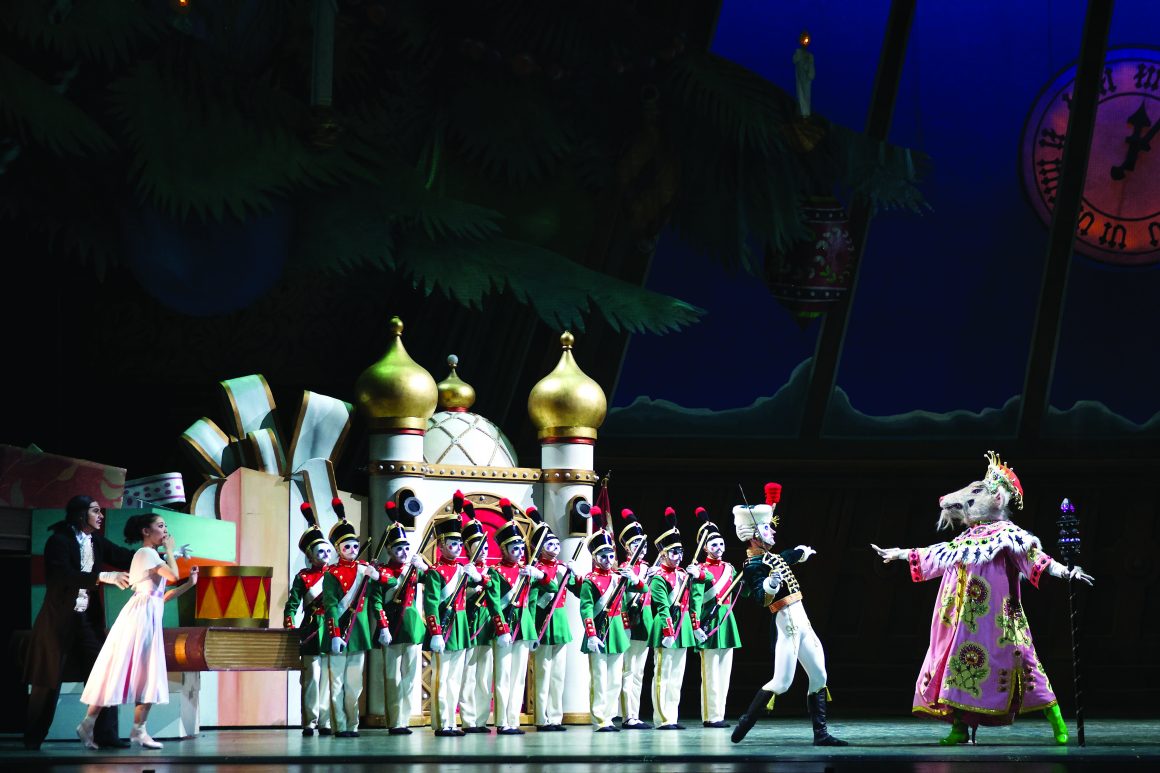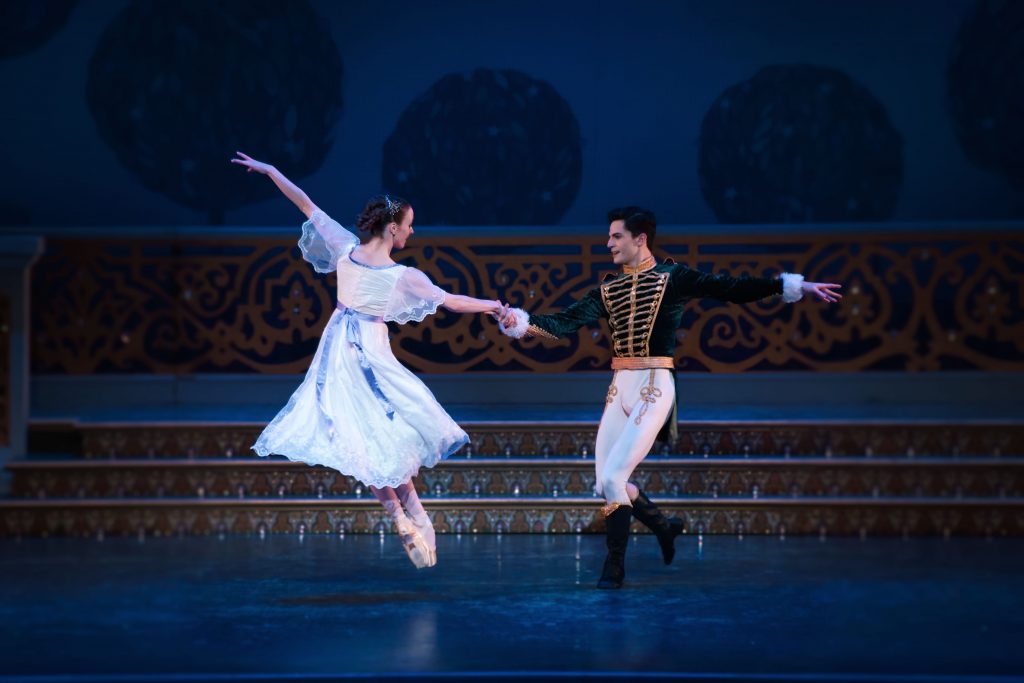
Review: Alberta Ballet’s The Nutcracker
By Aymen Sherwani, December 18 2022—
The story of the Nutcracker is loosely based on a 19th-century Prussian tale written by E.T.A. Hoffman, The Nutcracker and the Mouse King, in which a young girl’s beloved Christmas toy — a wooden Nutcracker — comes alive, battles the evil Mouse King, and then whisks her away to an enchanted kingdom of flowers and confections. Two centuries later, Pyotr Ilyich Tchaikovsky’s classical composition accompanying the story is what lives in the hearts and minds of everyone in December.
The modern interpretation of Tchaikovsky’s The Nutcracker, however, has come a long way from its roots — many critics in recent years have called for the removal of some orientalist tropes in Act II of the ballet which depict caricatures of Arabian and Chinese characters, rife with hyper-sexualized scenes of harems and White performers in rice paper hats and “yellowface” makeup. Last year, the Alberta Ballet opted for the complete removal of the Arabian and Chinese dances from their rendition of the ballet, in a move to be more mindful of cultural appropriation — albeit a shorter performance. This year, however, the national dances — Spanish, Arabian, Chinese and Russian — have been removed entirely and replaced with sweet confections — Marzipan, Caramel, Peppermint and Popcorn — with Tchaikovsky’s compositions completely reimagined to reflect the styles of these beloved desserts.
In an interview with the Gauntlet, the longtime choreographer of the Alberta Ballet — Edmund Stripe — reflects on the past, inclusivity, and navigating change in a way that preserves the integrity of a tale as old as time.
“I was approached by Christopher Anderson, the incoming artistic director of the Alberta Ballet, to see if I would reconsider or revisit the national dances in Act II to be a bit more in line with today’s way of thinking in the 21st century — to make the performance resonate with as many people as we possibly can access,” said Stripe, who has been with the Alberta Ballet company since 2002 and has been the choreographer for The Nutcracker since 2008.
Performing arts like the ballet have historically been characterized by their racial and class-based exclusivity, catering majorly to those who are wealthy and White. For the most part, this has started to change as ballet companies are becoming more diverse, but the narratives that are perpetuated by these stories continue to communicate such exclusion. The second act of The Nutcracker has historically perpetuated themes that, rather than diversifying the ballet, seek to otherize the nationalities. This is also precisely the reason why this change was so desperately needed in growingly diverse cultural centres like Calgary and Edmonton — for the sake of inclusivity and preserving the art of ballet.
“Initially, the issue was about how we would actually reinterpret the dances but I ended up with sweets or confections,” said Stripe. “To further distance myself from any of the decision making, I had a little vote with my colleagues and students that go to the ballet school, I gave them quite a long list of confections and spices and I played the music for Act II, which would be the national dances, and I asked them to choose which confections suited which piece of music.”

Before seeing this year’s version of the story, many questions come to mind about how one would go about reimagining compositions that are meant to reflect racial caricatures to be, instead, completely removed from their origins. How exactly is the Chinese Dance reinterpreted as the Peppermint Dance? How does the Arabian Dance become the Caramel Dance? This is where Stripe’s experience as a choreographer came in and completely blew me away.
“We took the palette and the sort of textures of the confections and put them into the costume, so, like I said, there’s no big lumps of cake flying around, but ‘Popcorn’ would have big, puffy sleeves,” Stripe said. “Caramel, it’s very, very exotic, and the texture of the music is a creamy caramel, so the movement [of the dance] is a direct mirror of that — very soft, it’s very gooey [and] a lot of the choreography itself is exactly that same way.
“There’s something the same with popcorn — the music is every poppy — hands popping and big jumps and leaps, like bursting out of a popcorn bag,” he continued, commenting on how those same movements have been used to reflect cultural stereotypes in the past. “I’m hoping the audience will see it as a positive change.”
If I hadn’t seen previous productions of The Nutcracker ballet and this year’s production was my first time, you couldn’t have told me that the original intention for Act II’s compositions was rooted in depictions of different cultures. Instead of the heavily fetishized Arabian Dance, the Caramel Dance was a dimly-lit, slow and sensual performance with two men and one woman in costumes that — quite literally — reflected the ripples and textures of the confection. When one thinks of caramel, one thinks of words like “rich,” “warmth,” “sweet yet spicy” and the way it just melts in your mouth — the choreography this year reflected that with the way the performers eased into each other in each step.
I was concerned more with the way the Chinese Dance would be reinterpreted as the Peppermint Dance, but in the end, I was pleasantly surprised. While this part of Tchaikovsky’s composition does have orientalist scales and instruments such as the flute — coded for the “Far East” — the music being reimagined to be associated with peppermint made so much sense once I witnessed it. It was lively, energetic and “cooling” — with the flute brilliantly resembling the cold sweetness of peppermint, this is definitely a more fitting aesthetic for the original music.
Ultimately, the direction that Stripe and the Alberta Ballet company have taken with The Nutcracker is one that falls in line with the rest of the story’s enchanted kingdom — making the original national dances seem almost out of place. I would strongly recommend attending this year’s version of a Christmas classic and the ballet’s redemption arc for yourselves.
The Alberta Ballet company will be hosting The Nutcracker from December 16 to 24 this year — whether you’re a longtime ballet fan, excited for Christmas or maybe just looking to explore exciting art forms, this year’s ballet is one that you should not miss.
